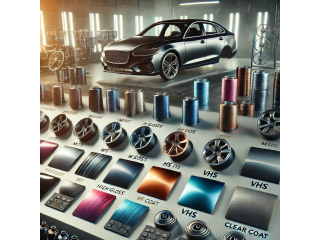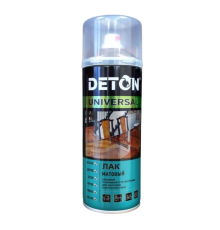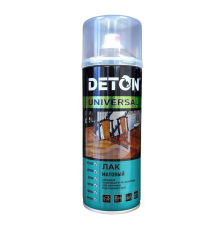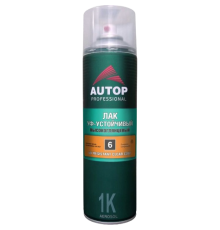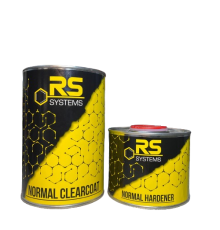Automotive clear coat is the final touch that not only adds shine and depth to a car's paint but also protects it from external factors. A high-quality clear coat extends the longevity of the paint job and protects it from UV rays, moisture, and minor damage. In Kazakhstan and Russia, with their diverse climate conditions, automotive clear coats are especially important for prolonging a vehicle’s body lifespan and maintaining its aesthetic appeal. This article explores the purpose of automotive clear coats, their types, application methods, and main areas of use.
Why is an Automotive Clear Coat Needed?
A clear coat serves several essential purposes:
- Surface Protection — The clear coat forms a protective layer that shields the paint from UV rays, moisture, and chemicals. This is particularly important for vehicles that spend a lot of time outdoors.
- Enhancing Appearance — Clear coats add shine and depth to the color, creating an attractive finish.
- Extending Paint Lifespan — A protective clear coat layer helps prevent the paint from wearing out quickly, allowing the car body to retain a fresh look for longer.
Types of Automotive Clear Coats
There are several main types of clear coats, each suited to specific purposes and needs:
Acrylic Clear Coat
One of the most popular types, acrylic clear coats provide a durable coating resistant to external effects. Acrylic clear coats dry quickly, are UV-resistant, and create a deep gloss.Polyurethane Clear Coat
Polyurethane clear coats are highly durable and resistant to chemical exposure. They form a long-lasting coating that withstands extreme weather conditions, making them ideal for vehicles operating in harsh climates.Matte Clear Coat
Matte clear coats give a sophisticated matte look, creating a modern and unique appearance. Matte finishes require special care but add a distinct character to the vehicle.Gloss Clear Coat
Gloss clear coats create a high-shine “mirror” effect. This type of clear coat is commonly used in auto tuning and is suitable for show vehicles.Nano Clear Coat
Nano clear coats are developed using nanotechnology to enhance protective properties. They offer water-repellent features and increased resistance to minor scratches.
Clear Coat Types by Solids Content: MS, HS, and VHS
Clear coats are also categorized based on solids content, which impacts coating strength and longevity:
MS (Medium Solid) — clear coats with medium solids content (35-45%). These clear coats provide a smooth, even finish and are easy to apply. They are mainly used for decorative purposes, though they require maintenance to retain their gloss.
Advantages of MS Clear Coats:
- Easy application.
- Suitable for creating a uniform finish.
- Affordable and versatile.
HS (High Solid) — clear coats with high solids content (50-60%). These clear coats are known for their increased resistance to UV rays and mechanical damage. They’re ideal for protecting the vehicle’s exterior but require professional skill for a smooth application.
Advantages of HS Clear Coats:
- High resistance to harsh conditions.
- Long-lasting finish.
- Excellent choice for exterior vehicle protection.
VHS (Very High Solid) — clear coats with very high solids content (over 65%), used for professional-grade coatings. They form a thick, durable layer with minimal coats. Applying VHS clear coats requires professional expertise for an even result.
Advantages of VHS Clear Coats:
- The most durable and resilient finish.
- High resistance to mechanical damage and chemicals.
- Perfect for vehicles in tough environments.
Application Methods
Applying an automotive clear coat requires specific preparation and technique. The main steps are as follows:
Surface Preparation – The car's surface should be thoroughly cleaned and degreased for an even clear coat application.
Clear Coat Application – Clear coats are applied using a spray gun or aerosol. They are typically applied in two to three layers, allowing each layer to dry.
Drying – After each layer is applied, time is needed for drying. In professional conditions, drying is performed in a dedicated booth to improve the quality of the finish.
Polishing – Once the clear coat is fully dry, it can be polished to enhance shine and improve the coating’s appearance.
Areas of Use
Clear coats are applied in various fields and for different purposes:
- Protecting the Car Body — The main use of clear coats is to protect the body from UV rays, moisture, and mechanical damage.
- Tuning and Personalization — Different types of clear coats help create a unique look for the vehicle, such as matte or mirror finishes.
- Restoration and Repair — Clear coats are used after repairs to restore the original look of the vehicle.
- Interior Part Protection — Clear coats can also be used on interior parts to provide protection and enhance appearance.
Pros and Cons of Automotive Clear Coats
Pros:
- Durability and Protection — Clear coats protect automotive paint from fading and minor damage, extending the lifespan of the finish.
- Aesthetics — Clear coats give the car a beautiful gloss or unique matte effect, enhancing its appearance.
- Resistance to UV and Chemicals — Modern clear coats are resistant to sunlight and chemical exposure, which is essential in changing weather conditions.
Cons:
- Requires Maintenance — Some types of clear coats, such as matte, require special maintenance to keep their look.
- Cost and Application Complexity — High-quality clear coats and professional application can be costly and time-intensive.
- Susceptibility to Damage — While clear coats are protective, they can still scratch and require periodic polishing.
Conclusion
Automotive clear coats play a critical role in car care by extending the paint’s lifespan and enhancing the vehicle’s style. The type of clear coat depends on the desired effect, operating conditions, and budget. Modern clear coats, such as MS, HS, and VHS, offer solutions for various needs, providing both protection and aesthetic appeal.

